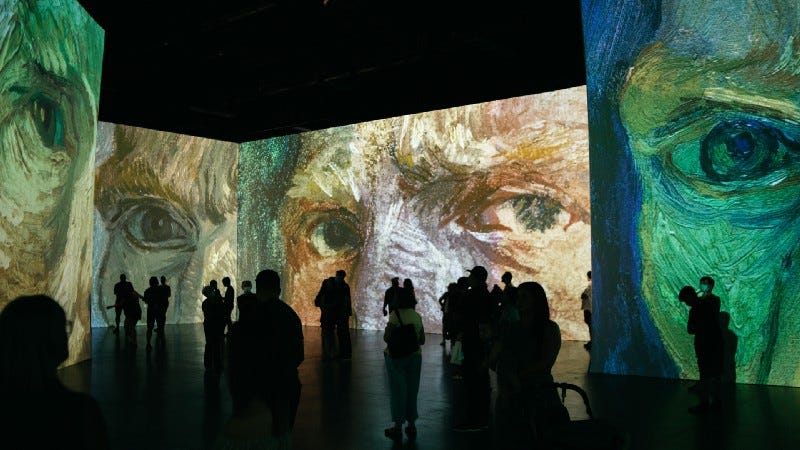We Need V-aRt Experiences
Virtual Reality needs to be the next phase in creating Immersive Art Experiences.
Recently I was fortunate to attend the Van Gogh Immersive Experience and I really feel that the piece needs to be a VR experience.
The popularity of the Van Gogh exhibit is completely warranted and I thoroughly enjoyed my time. The artists are to be commended on their thoughtful audio and visual presentation of fantastic pieces of art.
My thoughts below are on how the concept could be enhanced through the utilization of VR and why this medium should become more prevalent.
“Immersion” vs Immersion
During my time passively exploring VR experiences, the concept of optimizing the immersive experience is often discussed. Creating an environment and experience that is seamlessly constructed to convince the user’s brain that they actually are in a different place is a very complex task. Thus the use of the “immersive” adjective for the Van Gogh exhibit was an interesting choice.
In the Van Gogh experience, the piece is projected on the four walls (and sometimes the floor) of the space.
The concept of “immersion” seems to come from the fact that the piece is “all-around” you during its presentation. I do applaud the positioning of the projectors as there were no instances of shadows on the main walls.
However, there were a few things to note for those that could be critical of the “immersion” element.
The floor and ceiling were not used to facilitate a full x-axis and y-axis 360-degree experience.
The walls were mostly clear, but doors, wall seams, exit signs, fire alarms, and fire extinguishers were clearly visible.
While I understand the impracticality of this one… other people.
Each of the concepts listed above is not meant to be a critique, but more of a reflection on the amount of “immersion” that is possible in a physical space in comparison to a virtual environment.
These challenges are inherent when desiging for a physical space, but are not something to be addressed as they aren’t present in a virtual environment.
While slight nuances, any obstacle that brings you back to “reality” is something that breaks immersion. If we could mitigate these items, through the use of a virtual environment, then the experience becomes that much more immersive to the user.

Immersive Art: Anywhere, Anytime for Anyone
As I mentioned at the top, I was fortunate to live near a gallery offering the experience, have time to book a space, and have the money to pay for and travel to the exhibit. This isn’t the case for everyone.
As someone who has seen a fair amount of art, the experience is immeasurable for exploration opportunities and conceptual reflection. While the reality of art creation often requires the consideration of cost, helping more people experience a piece also has significant value.
With the explosion in popularity of personal, non-pc, VR headsets; the potential for creating immersive art experiences feels much more possible.
I understand that this is somewhat a juxtaposition to what I previously wrote about cost, but my speculation is based on the projection that personal VR devices, including those that are 3DOF (degrees of freedom), such as Google Cardboard like setups, will become more ubiquitous in the near future.
Designing art experiences for consumption on these devices would increase access to viewers, mitigate the logistics of immersion disruption caused by physical spaces, and allow users a more individual and personalized opportunity to experience the piece.
Is it time for VR Art?
While VR is not something I am able to currently commit a ton of time to, to me it is a resource that COULD address empathy, equity, creativity, and access. With that being said, I want others to consider that VR is not just about games and we should not let gaming become what people assimilate as VR.
I wrote a piece a few years ago (link here) about the future of the VR industry, as someone who was interested in future uses, and I now feel that we (that is everyone) need to proactively think about how this TOOL can be used to improve the human experience.
Whether this is socially, culturally, personally, physically, mentally, or otherwise… Virtual Reality can be an asset to a better future and Art is also an asset with that same vision, so why not combine the two with the hopes of a synergistic reaction for good.
Thank you for the value of your time as you read my piece. Below is another link to my previous piece about the future of VR, as well as another piece regarding virtual content being used in other spaces. Please follow me if you feel that my work empowers, inspires, or speaks to you in some way.
Dead or Alive: What is going on with the Virtual Reality Industry?
Recently there has been a myriad of articles debating the state of the Virtual Reality (VR) industry. While feeling…arvrjourney.com
Hey XR, don’t forget about education!
The more years that I teach, I continue to see that learning is a deeply personal endeavor. Whether it is through my…medium.com
My name is Andrew Julian and I am a teacher of computer science and technology. I have a passion for considering how technology can positively impact a classroom and the education of all people.
Check out my website at andrewjohnjulian.com for more information.


